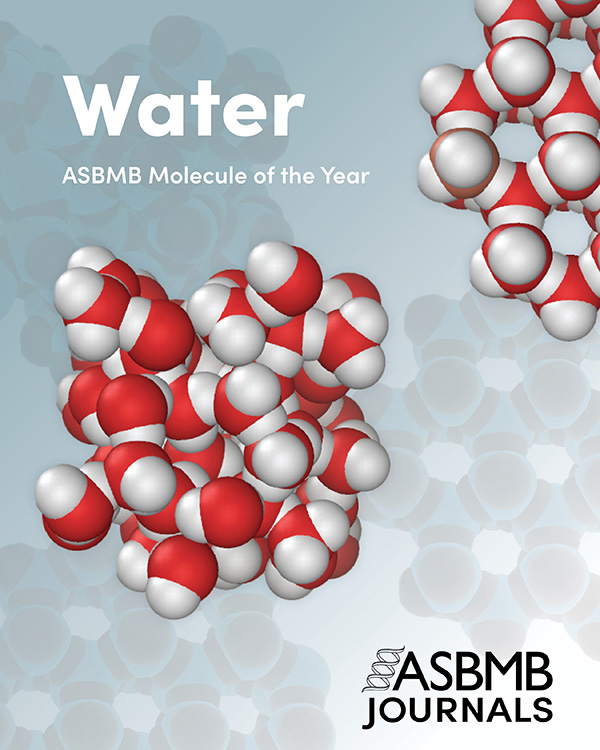
Virtual issue celebrates water in ASBMB journals
After the American Society for Biochemistry and Molecular Biology voted to name water the 2024 Molecule of the Year and members were invited to write essays on the topic, the publications staff decided to highlight water in research from the society’s journals.

ASBMB Publications Director Isabel Casas and Assistant Publications Director Chengmin Jiang assembled a virtual issue that is now available and includes 12 gold open-access articles from the past three years covering exciting research in the Journal of Biological Chemistry, the Journal of Lipid Research and Molecular & Cellular Proteomics.
Studies on macromolecular structure are part of this issue, including a toxic RNA structure associated with disease and cryo-electron microscopy results that shed new light on water oxidation to produce oxygen by the photosynthesis enzyme photosystem II, or PSII. A group crystallized a pathogenic structure formed from trinucleotide repeats in RNA and observed a water bridge within a mismatched base pair, providing important information on this RNA duplex conformation associated with myotonic dystrophy type 1.
Additionally, two articles cover insights into PSII, in one case to understand architectural changes that allow water oxidation to occur at the lower energy limit in cyanobacteria acclimated to far-red light. In another study, scientists analyzed the PSII structure to determine that mutating a conserved residue disrupts key water channels.
Another set of studies highlights work on water influx into cells. Scientists found that a plant aquaporin, a protein key to solute transport across the membrane, not only shuttles water but also accepts sucrose and lactose as substrates. These results could have implications for plant growth and food production. Furthermore, knowledge of the aquaporin protein fold contributed to deciphering key components of a formate–nitrate transporter that has the same fold but with specific constriction sites important for formate movement.
Researchers also investigated water permeation into cells due to damage, such as lipid peroxidation. Aggregates of a dicarboxylic acid compound in the membrane led to the beginning stages of water pore formation, which could be relieved by adding flavonoids as antioxidants. Finally, scientists focused on water influx in T cells to determine that the cells start rapidly taking in extracellular water before cell division in a shift from the slower gain of water from glycolysis.
Finally, this collection highlights papers with water-related methods used to answer diverse questions in biochemistry and molecular biology. Water with deuterium, or heavy water, is a key research tool for mass spectrometry. One group tackled the complicated issue of measuring protein turnover rates in animals and provided a comparison of two methods using heavy water versus stable isotope–labeled amino acids. Another group used heavy water and stable isotope–labeled cholesterol to determine the biosynthetic origin of cholesterol in the retina and brain.
Scientists also have taken advantage of the phase separation properties of water with organic solvents to enhance current methods for extracting hormones such as estrogens, androgens and progestogens from serum. Furthermore, researchers measured learning and memory of mice with the Morris water maze test to assess whether a compound that increases activation of protein quality control genes could alleviate signs of neurodegenerative disease.
Lastly, a group measured trans-epidermal water loss through models of varying lipid compositions associated with inflammatory skin diseases to gain insight into barrier functionality.
Find out more about the extensive role of water in biochemistry and molecular biology research by checking out the new ASBMB Journals virtual issue.
Read more
Read more articles and essays about our ASBMB Molecule of the year.
Water, you say? Sephra Rampersad recalls a great scientist asking, what is the one critical component that could make or break your experiment in any lab?
Water takes center stage Danielle Guarracino remembers the role water played at two moments in her life, one doing scary experiments and one facing a health scare.
What I’ve learned about water, aging and protein quality control Alice Liu thought an increase in heat shock protein chaperones would prevent misfolding in Huntington’s disease proteins. The results surprised her, and water was the key.
The subtle strength of hydrogen bonds Indu Sridharan remembers how water complicated her atomic force microscopy imaging studies of collagen.
The teaching power of water “I questioned whether children would be very interested in this exercise; there wasn’t much to it.” At an outreach event, Jessica Desamero learns that three cups of water can convey complex science.
Water rescues the enzyme “Sometimes you must bend the rules to get what you want.” In the case of using water in the purification of calpain-2, Dorothy Croall writes, it was worth the risk.
There are worse things in the water than E. coli E. coli levels determined whether Olympic swimmers could dive into the Seine this past summer. But are these bacteria the best proxy for water contamination? Andrea Luis investigates.
Molecular impressions of water as cuneiform cascade Inspired by "the most elegant depiction of H2O’s colligative features," Thomas Gorrell created a seven-tiered visual cascade of Sumerian characters beginning with the ancient sign for water.
Enjoy reading ASBMB Today?
Become a member to receive the print edition four times a year and the digital edition monthly.
Learn moreGet the latest from ASBMB Today
Enter your email address, and we’ll send you a weekly email with recent articles, interviews and more.
Latest in Science
Science highlights or most popular articles

E-cigarettes drive irreversible lung damage via free radicals
E-cigarettes are often thought to be safer because they lack many of the carcinogens found in tobacco cigarettes. However, scientists recently found that exposure to e-cigarette vapor can cause severe, irreversible lung damage.

Using DNA barcodes to capture local biodiversity
Undergraduate at the University of California, Santa Barbara, leads citizen science initiative to engage the public in DNA barcoding to catalog local biodiversity, fostering community involvement in science.

Targeting Toxoplasma parasites and their protein accomplices
Researchers identify that a Toxoplasma gondii enzyme drives parasite's survival. Read more about this recent study from the Journal of Lipid Research.

Scavenger protein receptor aids the transport of lipoproteins
Scientists elucidated how two major splice variants of scavenger receptors affect cellular localization in endothelial cells. Read more about this recent study from the Journal of Lipid Research.

Fat cells are a culprit in osteoporosis
Scientists reveal that lipid transfer from bone marrow adipocytes to osteoblasts impairs bone formation by downregulating osteogenic proteins and inducing ferroptosis. Read more about this recent study from the Journal of Lipid Research.

Unraveling oncogenesis: What makes cancer tick?
Learn about the ASBMB 2025 symposium on oncogenic hubs: chromatin regulatory and transcriptional complexes in cancer.

